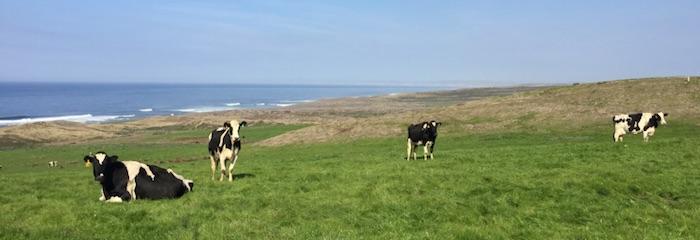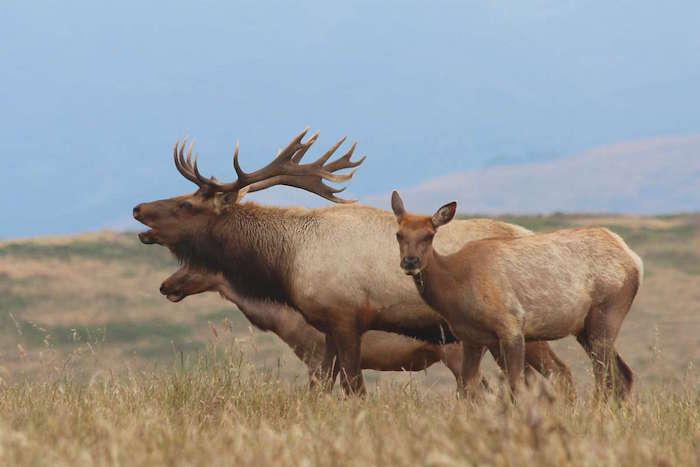
Should cattle gain an advantage over Tule elk at Point Reyes National Seashore?/NPS
The first time I drove to the Point Reyes Lighthouse, I was horrified to see large cattle ranching operations on National Park Service lands.
The adverse impacts of ranching on soils, water quality, vegetation, wildlife and visitor experience were undeniable: piles of manure, muddy trails, accelerated erosion, weed-infested pastures and gigantic heaps of rotting vegetation called silage (pasture plants are mowed and then fermented to feed livestock when there is no grass available). During the four years I worked at Point Reyes, I never drove past the ranches without shaking my head.
The ranched lands at Point Reyes are largely coastal prairie, which historically occurred from northern Los Angeles County into Oregon. More than 90 percent of this plant community has been disturbed or lost to development. In other words, the coastal prairie, as well as the plants and wildlife it supports, is rare and deserves full protection and restoration.
My co-workers understood that the ranches were “grandfathered” in under the national seashore’s enabling legislation. The government had purchased the ranches, and was to allow ranch operations to continue under leases for 25 years, or until the death of the ranch owner or his or her spouse.
I was not the only employee who believed the ranches had unacceptable environmental and social impacts, but for many years the Park Service could not, or simply chose not to, address the issue head-on — not until they were sued over those impacts.
In July 2017, the plaintiffs, ranchers, and the National Park Service reached a settlement — the Park Service could extend grazing leases for five years and was to complete a comprehensive environmental assessment of the ranches and subsequent general management plan within four years. This agreement was considered a win-win by all.
Then, suddenly, out of left (or, in this case, right) field, U.S. Reps. Jared Huffman, D-San Rafael, and Rob Bishop, R-Utah, quickly pushed a bill (HR6687) through the House of Representatives that attempted an end run around the settlement process, basically ordering the National Park Service to issue 20-year leases to the ranchers, and expressly putting the needs of ranches above the needs of natural resources and native wildlife (e.g., Tule elk).
Why did Huffman and Bishop try to force the Park Service to change the national seashore’s enabling legislation ahead of the environmental assessment of the impacts of the ranches? Perhaps because they knew at least some of the impacts of ranching on the environment at Point Reyes National Seashore would be, per the National Environmental Policy Act, “significant.”
Rather than allowing the National Park Service to conduct a thorough impact analysis and decide, with full public input, the fate of these private enterprises on public land, these politicians are trying to impose their will in favor of the ranchers. It appears that under an administration that clearly favors the economy over all else, and seems intent on privatizing as much of our public land as possible, Huffman and Bishop saw their chance to curry favor in Washington, at the expense of the integrity of Point Reyes National Seashore.

Tule elk could be managed under strict population caps if legislation to make ranching permanent at Point Reyes National Seashore passes/NPS
When considering HR6687, I urge our senators to do the right thing, to consider the needs and desires of all U.S. citizens — all of whom have a stake in Point Reyes National Seashore — as well as the needs of the land itself and the wildlife it supports. HR6687 should not be passed. Instead, allow the legal processes of environmental review and planning to go forward, and do not allow private interests to run roughshod over both the processes and the incomparable beauty and richness of Point Reyes National Seashore.
Let the National Park Service conduct its comprehensive analysis and, based on the data, (1) determine whether or not ranching can continue without harming the environment or the experience of the millions of people who visit the national seashore every year, and (2) if any of the ranches should be phased out or have their operations modified. To preempt this process in favor of private interests would be a breach of the public trust.
Barbara J. Moritsch worked as a plant ecologist for the National Park Service at Point Reyes National Seashore from 1998 to 2002. She is an occasional contributor to the Traveler.



Comments
The thing is, Rep. Huffman can hardly be called right field. He's one of the most consistently pro-environment and pro-science voices in the House and on the Natural Resources Committee. It's baffling, and he hasn't given a rational explanation for introducing the bill yet, given that there is a general management plan update in process. He insists the bill does nothing to change that, but its mere existence and terms put pressure on the Park Service.
National Parks should be for wildlife, natural-nature and low-impact visitors to enjoy not miles of barbed-wire, pollution, poo-pond and pee-creeks that for-profit cattle and dairy corporate industries offer the National Parks.
Scott - you do realize that Point Reyes was "barbed-wire, pollution, poo-pond and pee-creeks that for-profit cattle and dairy corporate industries" before being designated a NP. By the way, are you a vegetarian?
The article mentions the ranches were grandfathered in under the legislation designating the park. Are these leases permanent? Can their leases be bought out? I say either buy them out at fair market value or wait until the leases expire. It also mentioned 25 year leases when it was park was designated. If that's the case, then they should be coming up for expiration in a few years. Let them expire and/or buy them out.
it well might have been, but at the time it was designated a national seashore, the area was under threat of massive housing development, and the landscape (despite the ranches) was felt worthy of protection, which is why the Seashore was established. The ranchers were given generous buyouts and lease backs in order to get their support for the seashore, But there was never any understanding orignally that the dairy farms would be permanent fixtures. It's not clear why the buy-back-leases haven't mostly run their course, though their term was for 25 years or the life of the rancher or their spouse, whichever was later, so maybe they are long-lived, hearty folk.
It seems the Park Service / Interior Department felt they could ignore that stipulation and rely on local supporters of dairying to carry the day ahould any political interference arise. That's the scenario that is playing out now. Prominent ag supporters have admitted that they want to change the intent of the park to preserving agriculture. And just a week or so ago, the Park Service announced that many of the ranches had been placed on the national Regiser of Historic Places--right up there with Independence Hall and Mt.Vernon ! </s>
And 10s of thousands of far less significant places. Have you ever looked at what is actually on that list?
They weren't necessarily permanent. However, the legislation authorizes the land to be leased back. This was done as 5 and then 10 year leases. When Ken Salazar issued his memo denying the 10 year special use permit for Drakes Bay Oyster Company, he threw in a recommendation that the special use permits for the ranches should be increased to 20 year terms.
https://www.doi.gov/news/pressreleases/secretary-salazar-issues-decision...
Here's the relevant part of the legislation:
https://www.gpo.gov/fdsys/pkg/USCODE-2010-title16/html/USCODE-2010-title...
Preserving agriculture is in the legislation (15USC459c-5(a)) and has been since 1978. The original 1962 legislation wasn't so clear about how this would be done, but that was apparently clarified in 1978 via Public Law 95-625. The law currently in place set up the life estate or 25 years at the rancher's choice. It also allows for the land to be leased after those terms, with the original owners having first dibs.
The reason why the owners would agree to sell were complex. The entire dairy community was worried that this land being developed into housing would mean the loss of dairy cows and could make West Marin's dairy processing facilities less viable from loss of business. Many wanted to keep their way of life. Also - several of the ranches were not owned by the ranchers. They were tenant farmers who were worried that their landlords would sell out to housing developers. I've read somewhere that RCA was the biggest landowner in the area. I'd also think the landowners who sold got a sweet deal where they were no longer liable to pay property taxes and got a really good lease.